A quick history lesson
Waitby, a small hamlet and township near Kirkby Stephen in Cumbria, has a rich history that stretches back the Stone and Iron ages. It once had its own castle, comprising a Romano-British settlement, about a quarter of a mile east of the hamlet.
For the history buffs among you, the castle is an oval shaped hilltop enclosure at the top of the hill; its earthworks and buried remains, along with a length of medieval dyke, have been designated a Scheduled Monument.
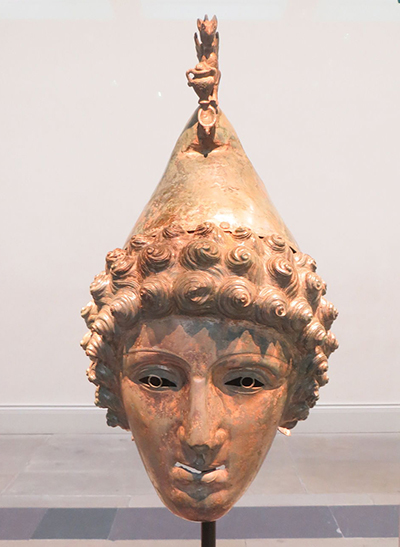 In May 2010, a two-piece Roman cavalry helmet was discovered in Crosby Garrett, less than two miles from Waitby School. Only two other Roman helmets with visors have been discovered in Britain and this find was an almost complete example of a two-piece Roman cavalry helmet, with its visor still intact and showing signs of wear caused by it having been opened and closed. It is thought that this would have been worn for cavalry sports rather than for battle (the helmet is pictured right. Image courtesy Jonomac under the Creative Commons Licence).
In May 2010, a two-piece Roman cavalry helmet was discovered in Crosby Garrett, less than two miles from Waitby School. Only two other Roman helmets with visors have been discovered in Britain and this find was an almost complete example of a two-piece Roman cavalry helmet, with its visor still intact and showing signs of wear caused by it having been opened and closed. It is thought that this would have been worn for cavalry sports rather than for battle (the helmet is pictured right. Image courtesy Jonomac under the Creative Commons Licence).
There are many Roman roads in the area and it is humbling to see such a tangible and sophisticated reminder of the people who found themselves here thousands of years ago. It is hard not to wonder what the wearer thought of the fells and the countryside (and the weather, which can be wild).
Today, the hamlet of Waitby is a picturesque huddle of ancient houses and a farm, but without much obvious evidence of the thriving market town it once was. Family lore has it that the ruins of a building as you enter the hamlet are the remains of an ancient inn.
If you travel past Waitby hamlet, winding up the road, you will come to Waitby School, which was built in 1680, thanks to an endowment from James Highmore, a native of Waitby who moved to London as a cloth-worker. Among other bequests to the poor and the church on his death in 1684, his will left a further £300 to be laid out in the purchase of lands and £7 of the yearly profit to be employed for the school.
Intriguingly, A history of the manor of Crosby Garrett in Westmoreland, with local custom and legends by Josiah Walker Nicholson provides some details about the school and the area. It discusses how pack-horses were the main means of transporting goods such as pie-pans, scythes, sickles, as well as salt, spirits and groceries. The ancient road from Kendal to Barnard Castle passed on the southern border of Crosby Garrett, close to Waitby, and the book adds that the pack-horse transport “lingered long in these hilly districts.”
Even more interestingly (and rather amusingly), the book describes how Bishop Percy visited Crosby Garrett and asked to view the parish register. The Rector, no doubt experiencing extreme discomfiture, claimed that the register had been lost. But it seems that he may have been economical with the truth, as the book explains: “It appeared, however, that all the needful entries had not been made for some time, and the Rev S Hutchinson of Soulby, and Mr Thomas Brunskill, Master of Waitby School, with the assistance of the parishioners, remedied the neglect.”
It is impossible when reading such short snippets, not to imagine the embarrassment and stern conversations that must have taken place when Bishop Percy turned up. I'm trying to get a bizarre amalgam of scenes from Father Ted and Blackadder out of my head...
Brunskill was master at Waitby from 1820 until his death in 1860. Educated for the Church at a school in Orton, the Reverend Thomas Moss – who later became Vicar of nearby Ravenstonedale – Brunskill accompanied his uncle on a tour of France and Italy after completing his education. He was nominated to be Rector of Crosby Garrett by the Lord of Manor, but instead applied for the Mastership of Waitby School, which had just become vacant. He was successful in his application, despite: “Very severe competitive examination of the candidates.”
The book is a treasure trove, providing further details about Thomas Brunskill, over and above his generous donation of time to help bring the parish register up to scratch. Waitby School was linked with Crosby Garrett, as: “Many of the more advanced pupils used to finish their education with two or three years training at it.”
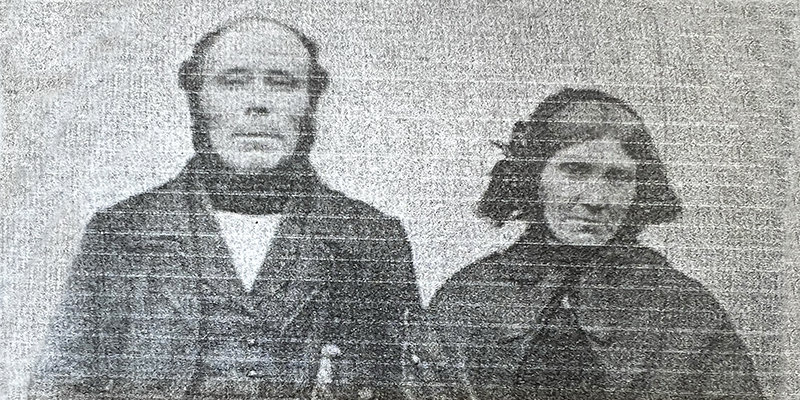
Thomas Brunskill, Master of Waitby School from 1820 to his death in 1860. He is pictured with his wife, Dorothy, who he married in July 1830 in Crosby Garrett (with thanks to Irene Kelly, one of his descendants, for this image and that of the list of pupils, Christmas 1824, below right)
The book continues: “During his tenure at Waitby Grammar School, he turned out some notable scholars, who afterwards became famous in several professions.”
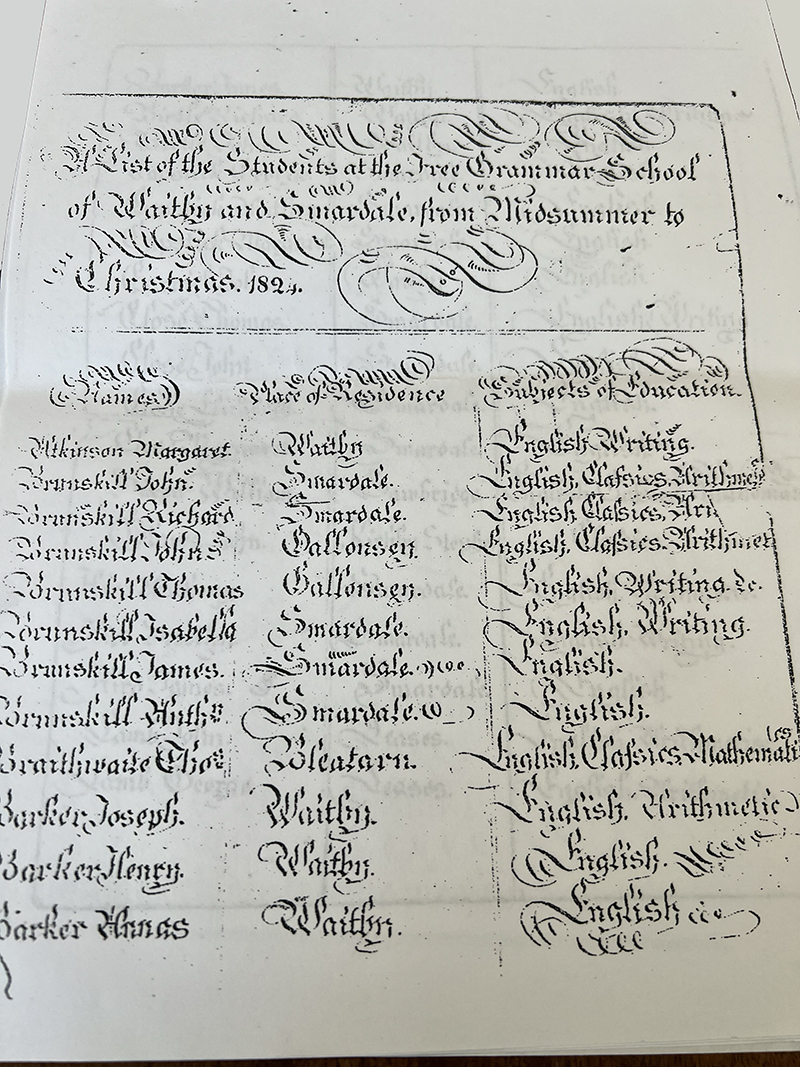 Hailing from Durham College, William Waistell succeeded Thomas Brunskill as Master in 1861 and, in 1867, Waistell was instrumental in rebuilding the school. An earlier description described how the roof of the original school was constructed: “Oak pegs were in general use for holding slates on the roof; sometimes lead nails were used, and even sheeps’ (sic) shank bones secured heavy grey slates in position in exposed situations. They had been used for the roof of the old school at Waitby.”
Hailing from Durham College, William Waistell succeeded Thomas Brunskill as Master in 1861 and, in 1867, Waistell was instrumental in rebuilding the school. An earlier description described how the roof of the original school was constructed: “Oak pegs were in general use for holding slates on the roof; sometimes lead nails were used, and even sheeps’ (sic) shank bones secured heavy grey slates in position in exposed situations. They had been used for the roof of the old school at Waitby.”
A wonderful description of the old school before rebuilding works is given: “The old building was a wretched place, 14 feet by 14 feet 10 inches, very low, with a loft above. On this, coals, ling and firewood were stored and, the boards being open, every time there was movement above, down came a shower of dust on the scholars. It was a smoky place when any wind was blowing, the walls were black, and altogether the old place resembled a smithy.”
A plaque with an engraved list of those who donated funds for rebuilding works – and how much they gave – still stands above the front entrance of Waitby School.
Around 1890, Waistell resigned and the school eventually closed in 1907. Says the book: “This has proved a great hardship to the inhabitants of the neighbouring hamlets; the more aggravating since it is known that a good endowment was left for the benefit of this school.” The County Council reopened the school in 1913 but it was finally shut down in the 1920s and the building was used as the Smardale village hall until it was abandoned in the late 1950s.
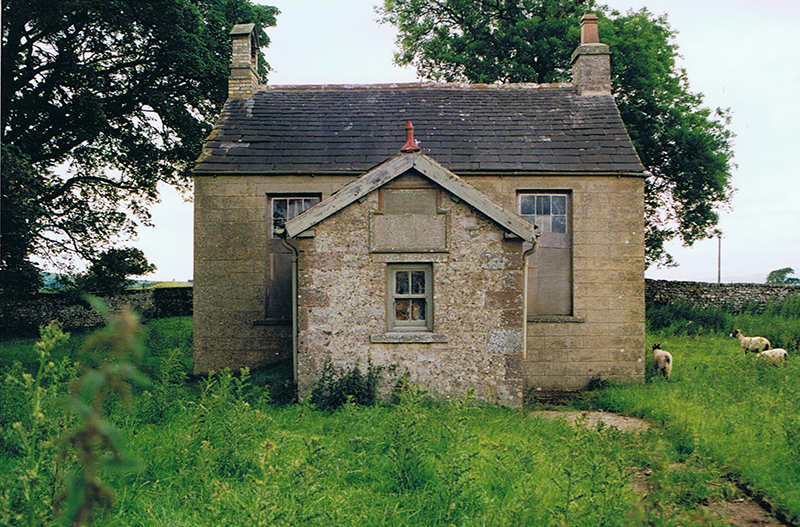
Waitby School, before renovations
And this is where our family came in. Mrs K S Broom, who was born and educated in Kirkby Stephen, had left the area to work in London, eventually marrying a farmer in Surrey. But she visited her many family and friends in Kirkby Stephen as often as she could and her links with the area remained strong. In 1973 the school building was bought as a surprise by her husband with a view to refurbishment so she could be nearer to to her relatives in Kirkby Stephen and the surrounding areas. Sadly, his death put paid to this plan and the school stood as it was for decades, empty but not forgotten. It was Grade II listed in October 1996. Ten years later, George, her middle son, embarked upon the massive labour of love to turn Waitby School into a home.
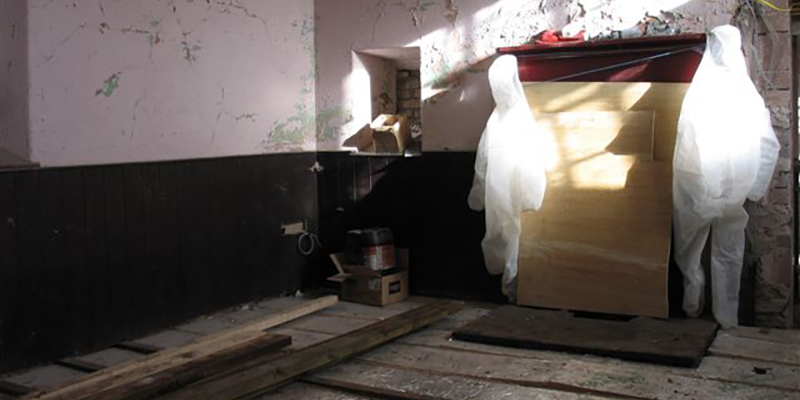
Above: the school room during renovation work, which was carried out under strict supervision of Historic England. Below, the room as it is today
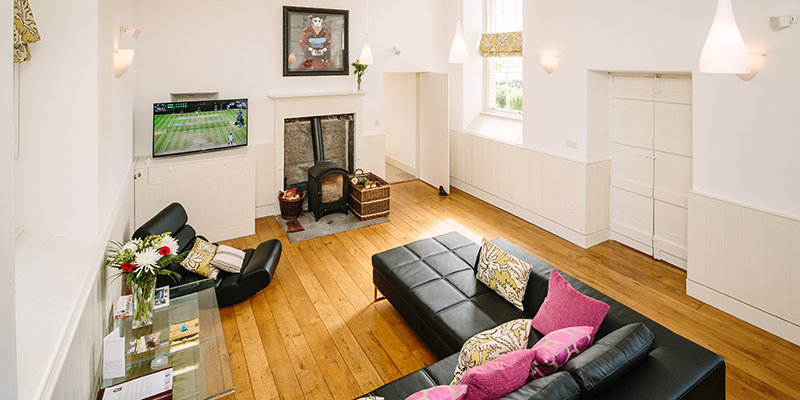
We worked closely with English Heritage during our renovation and refurbishment and, together with a talented local architect, came up with a plan that preserved the historical nature of the central school building and lobby, while incorporating all the touches needed for luxury residential accommodation. Wherever possible, we sourced local materials to reflect the history of the former school, while breathing new life into what was previously a rather forlorn building.
And there are hints and clues as to its past history everywhere – from the tall windows and panelling in the main room (we assume the windows were placed high to prevent children from gazing out and daydreaming), to the large fireplace and high mantel. The lobby still has plenty of coat hooks, and the old clay sink in the vestibule must have seen many grubby hands being washed after playtime.
Outside, the boys’ toilets remain in place and are virtually unchanged (see picture, below right). The wooden seat must have been utterly freezing to sit on in the winter... Unfortunately, the girls’ toilet had collapsed into rubble long before the building was sold, and although we wanted to rebuild it, this was not permitted under the Grade II listing conditions.
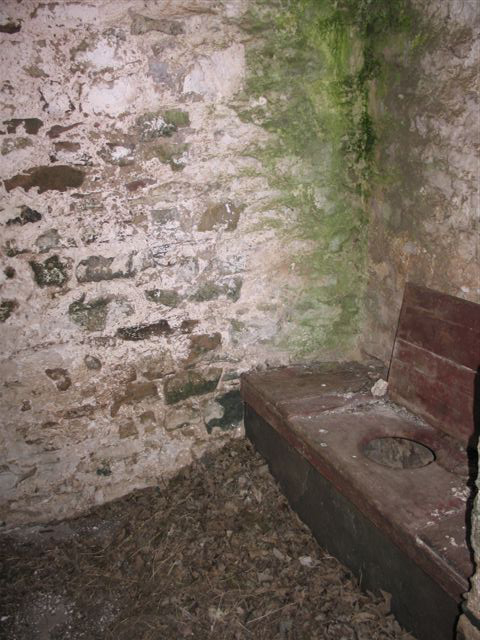 Other hints as to Waitby School’s rich human history abound. The old lead drainpipe outside the vestibule has seen some knocks and dents over the centuries, and the bell tower to summon the children remains in place. The original bell was stolen years previously, but we have sourced another one to replace it. The stone walls surrounding the school have stood long enough for lichen to grow upon them in intricate whorls.
Other hints as to Waitby School’s rich human history abound. The old lead drainpipe outside the vestibule has seen some knocks and dents over the centuries, and the bell tower to summon the children remains in place. The original bell was stolen years previously, but we have sourced another one to replace it. The stone walls surrounding the school have stood long enough for lichen to grow upon them in intricate whorls.
Indeed, it is the nature surrounding Waitby that is most enchanting, particularly the three majestic trees towering above the school. Today, they are home to at least one owl, a flock of chattering and inquisitive crows and we have seen a red squirrel scampering among the boughs. A large hare appears to have made its home in the garden and lopes around casually when it thinks nobody is looking.
One cannot help but wonder what events – of national and local importance – these veteran trees have lived through and what they have witnessed. They teem with life, rustling in the summer and swaying gently in the winter. They are the sound of Waitby School.
If only we could understand what they are saying.